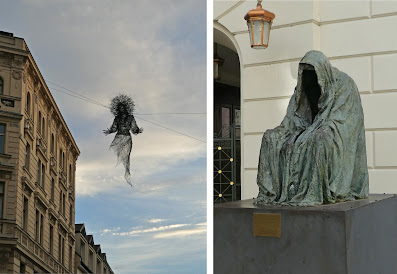Last week I returned from a wonderful family vacation, during which of course I was on the lookout (as I always am) for mythical, magical creatures. Today I’ll share photographs of some of the many fantasy beings I spotted during my travels. We begin with unicorns, that ever-popular staple of fantasy viewing. The large sculpture is one of a pair in the Mirabell gardens in Salzburg. The gardens were given a mythology theme in 1730, so I’m assuming that’s the date of the sculptures I’ve got here. It's got a magnificent beard! To contrast with the eighteenth century unicorn, I also spotted one from 1517 in a book in the Klementinum in Prague.
The Mirabell gardens are also home to this fierce Pegasus, which features in the “Do Re Mi” song from “The Sound of Music,” which was filmed here. (The unicorn sculptures can be glimpsed in the movie, too, on either side of the famous flight of steps in the song.) The mane is made of layered sheets of metal, rather than a solid chunk, which strikes me as unusual, although I'm certainly no expert on eighteenth century sculpture. While we’re on the subject of creatures with wings, here’s a ferocious winged lion in Prague. This one is much more recent, being unveiled in 2014 to commemorate the Czech members of the British Royal Air Force who served in the Battle of Britain during Word War II. Some interesting features include the double (triple?) tail and the claws on the wings.
From the winged lion it’s an easy transition to the griffins, which were all over the place. But some particularly fine examples are this unusually smooth, long-necked pair whom I spotted at the Prunksaal in the National Library in Vienna. That section of Baroque magnificence was completed in 1723. Then once again I’ve got the contrast between a Baroque subspecies and a medieval subspecies. The griffin sculpted on a terra cotta tile in Prague dates to the late 11th-early 12th century. Its claws are especially formidable!
A number of merpeople frolic in the seventeenth-century frescoes at the Wallenstein Palace Garden in Prague. This one has some fun touches, such as a fistful of coral and a seashell chapeau. I particularly like the fairy wings, and I wonder if they indicate that she’s actually a siren, a species that encompasses a good deal of confusion with both avian and piscine characteristics. She’s also either in very shallow water, or is exceptionally buoyant - or perhaps flapping those little wings hard enough to hold her aloft out of the water.
I spotted a flock of sixteenth-century tartolds, aka dragon shawms, at the Musiksammlung, Vienna. Alas, I didn’t hear them singing (roaring?) but I am informed that their double-reed voices are low in tone. I like their knotted tails, their curly tongues, and their happy grins. They do appear to have little arms and legs held tight against their bodies, which makes them something along the lines of the dachshunds of the dragon world. I might like to include tartolds as a new species in a story some time.
Unlike most gargoyles, this group in Prague was perched close enough to the ground that I could get a decent sight of them. Horns, beaks, wings… and the pigeon-discouraging spikes actually go quite well with the look. These are very handsome beasts, and they’re lucky their gothic habitat was preserved in a building that had mostly gone baroque.
Finally, a couple of ghosts haunting the streets of Prague. The most recent from 2022, is the wraith of a Ukrainian woman, and although the wire sculpture, with her vinok wreath on her head, is intended to commemorate all the mothers who have been affected by the war in Ukraine, I can’t help seeing it as something straight out of “Ghostbusters.” In the darkening sky of evening it definitely looks like a vengeful soul. And speaking of tormented souls, I also spotted Il Commendatore, the demonic statue who consigns Don Giovanni to the eternal torment of hell in Mozart’s opera, which was premiered at the Estates Theatre in Prague in 1787. This eerie sculpture from 2000 is not at all how I picture Il Commendatore (or how he was portrayed in the production
of “Don Giovanni” that I saw some 30 years ago), but in fact it’s much cooler and more evocative, so I'm not complaining.
Of course if you want to go on safari for mythical creatures, historical European cities are a rich hunting ground, and I was very lucky to be able to visit them with my family. But the moral of the story is to keep your eyes open wherever you are. You never know when you might catch a glimpse of something magical!
[Pictures: Unicorn, wood block print from Kneha lékarská by Jan Černy, 1517, in the Klementinum, Prague;
Unicorn, sculpture, c 1730, in the Mirabell Gardens, Salzburg;
Pegasus, sculpture, c 1730, in the Mirabell Gardens, Salzburg;
Winged Lion Memorial by Colin Spofforth, 2014, Prague;
Pair of Griffins, c 1723, in Prunksaal, Vienna;
Tile with a Gryphon, from St Lawrence Basilica, Vyšehrad, late 11th-early 12th century, in Museum of Decorative Arts, Prague;
Siren, fresco, 17th century, loggia of the Wallenstein Palace, Prague;
Three tartolds , German region, 16th century, in Musiksammlung, Vienna;
Gargoyles from Karolinum chapel bay window, c 1373, Prague;
Vinok by Veronika Psotková, 2022, Prague;
Il Commendatore by Anna Chromy, 2000, Prague (All photos by AEGN, 2023).]








No comments:
Post a Comment
I love to hear from you, but please no spam, ads, hateful language, or other abuse of this community.